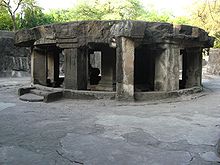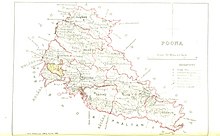History
Early and medieval[edit]
Copper plates dated 858 AD and 868 AD show that by the 8th century an agricultural settlement known as Punnaka existed where Pune is today. The plates indicate that this region was ruled by the Rashtrakuta dynasty. The Pataleshwar rock-cut temple complex was built during this era.[18]
Pune was part of the territory ruled by Seuna Yadavas of Devagiri from the 9th century to 1327. In 1595, Maloji Raje Bhosale was granted the jagirdari (Fiefdom) of Pune by the Ahmadnagar Sultanate. Pune was ruled by the Ahmadnagar Sultanateuntil it was annexed by the Mughals in the 17th century.
Maratha era[edit]
Pune was part of the Jagir (fiefdom) granted to Maloji Bhosale in 1599 for his services to the Nizamshahi of Ahmadnagar.[19]His grandson, Shivaji, the founder of Maratha Empire, was born in Shivneri fort not far from Pune. Shivaji was brought up by his mother in Pune. Pune changed hands several times between the Mughals and the Marathas in the period between 1660 and 1705. When Chhatrapati Shahu succeeded to the Maratha throne in 1707, he wanted to declare Satara the capital but his chief administrators, the Peshwa who were the real power behind the throne, decided Pune was to be their headquarters.
Bhosale Jagir era[edit]
After the destruction of the town in raids by the Adil Shahi dynasty in 1630 AD and again between 1636 AD and 1647 AD, Dadoji Konddeo, the successor to Dhadphale, oversaw the reconstruction of the town. He stabilised the revenue collection and administrative systems of areas around Pune and in neighbouring area of the Maval region. In addition, he developed effective methods to manage disputes and to enforce law and order.[20] Construction on the Lal Mahal began in 1631 AD. The Lal Mahal was completed in 1640 AD.[16] Jijabai is said to have commissioned the building of the Kasba Ganapati temple. The Ganesha idol consecrated at this temple has been regarded as the presiding deity (gramadevata) of the city.[21]
Shivaji encouraged the development of dams in Parvati and Kondhwa regions of Pune for agricultural purposes[citation needed]. Pune and its surrounding villages were the major recruitment areas for Shivaji's army between 1645 AD and 1680 AD. Between 1660 AD and 1670 AD the town was captured by Mughal General Shahista Khan, but was recaptured by the Marathas in 1670 AD after the Battle of Sinhagad. Shivaji often used Pune as his transit base during his major campaigns such as Varhad-Karanja (1673), AhemadaNagar District (1675), Karnataka (1677) and Jalna (1679). During the 27-year-long conflict between the Marathas and theMughals, the town was occupied by Aurangzeb from 1703 to 1705; during this time, the name of the town was changed to "Muhiyabad".[22] Two years later, once again the Marathas recaptured Sinhagad fort and later Pune from the Mughals.
Peshwa rule[edit]
In 1720, Baji Rao I was appointed Peshwa (Prime Minister) of the Maratha Empire by Shahu.[26] He moved his base from Saswad to Pune in 1728 and, in the process, laid the foundation for turning what was a Kasbah into a large city.,[27][28] Bajirao also started construction of Shaniwar Wada on the right bank of the Mutha River The construction was completed in 1730, ushering in the era of Peshwa control of the city. The patronage of the Maratha Peshwas resulted in great expansion of Pune with the construction of around 250 temples and bridges in the city, including the Lakdi Pul and the temples on Parvati Hill.[29] Many of the Maruti, Vithoba, Vishnu,Mahadeo, Rama, Krishna and Ganesh temples were built during this era. The building of temples led to religion being responsible for about 15% of the city's economy during this period.,[30][31]
Bajirao Peshwa constructed a lake at Katraj on the outskirts of the city and an underground aqueduct to bring water from the lake to Shaniwar Wada.[32] The aqueduct is still operational. Pune prospered as a city during the reign of Nanasaheb Peshwa. He developed Saras Baug, Heera Baug, Parvati Hill and new commercial, trading, and residential localities. Sadashiv Peth, Narayan Peth, Rasta Peth and Nana Peth were developed in this era. The Peshwa's influence in India declined after the defeat of Maratha forces in the Battle of Panipat but Pune remained the seat of power.In 1802, Pune was captured by Yashwantrao Holkar in theBattle of Pune, directly precipitating the Second Anglo-Maratha War of 1803–1805. The Peshwa rule ended with the defeat of Peshwa Bajirao II by the British East India Company in 1818.
British rule (1818-1947)[edit]
The Third Anglo-Maratha War broke out between the Marathas and the British East India Company in 1817. The Peshwas were defeated at the Battle of Khadki (then spelt Kirkee) on 5 November near Pune and the city was seized by the British. It was placed under the administration of the Bombay Presidency and the British built a large military cantonment to the east of the city (now used by the Indian Army).
The city was known as Poona during British rule.[34] The Poona Municipality was established in 1858. Railway line from Bombay and run by the Great Indian Peninsula Railway (GIPR) also reached the city in 1858,.[35][36] Navi Peth, Ganj Peth(now renamed Mahatma Phule Peth) were developed during the British Raj.
Center of Social reform and Nationalism[edit]
Pune was an important centre in the social and religious reform movements of the late 19th century. Prominent social reformers and freedom fighters lived here, including Bal Gangadhar Tilak, Vitthal Ramji Shinde, Dhondo Keshav Karve,Mahatma Jyotirao Phule and Dr. Raghunath Karve. Vinayak Damodar Savarkarresided in Pune when he enrolled in Fergusson College in 1902.
In late 1896, Pune was hit by bubonic plague. By the end of February 1897, the epidemic was raging with a mortality rate twice the norm and half the city's population fled. A Special Plague Committee was formed under the chairmanship of W.C. Rand, an Indian Civil Services officer. He brought troops to deal with the emergency. Although these measures were unpopular, the epidemic was under control by May. On 22 June 1897, during the Diamond Jubilee celebration of the coronation of Queen Victoria, Rand and his military escort were killed by the Chapekar brothers. A memorial to the Chapekar brothers exists at the spot on Ganeshkhind Road (University Road) between the Reserve Bank and the Agricultural College.
Pune was prominently associated with the struggle for Indian independence. In the period between 1875 and 1910, the city was a major centre of agitation led byGopal Krishna Gokhale and Bal Gangadhar Tilak. The city was also a centre for social reform led by Mahatma Jyotirao Phule, feminist Tarabai Shinde, Dhondo Keshav Karve and Pandita Ramabai. They demanded the abolition of caste prejudice, equal rights for women, harmony between the Hindu and Muslim communities, and better schools for the poor.[37] Mohandas Gandhi was imprisoned at Yerwada Central Jail several times and placed under house arrest at the Aga Khan Palace in 1942–44, where both his wife and aide Mahadev Desai died.
Pune since Indian Independence[edit]
After Indian independence in 1947 from Britain, Pune saw a lot of development, such as the establishment of the National Defence Academy at Khadakwasla and the National Chemical Laboratory at Pashan. Pune serves as the headquarters of the Southern Command of the Indian Army.[38] Industrial development started in the 1950s and '60s in Hadapsar, Bhosari, Pimpri and Parvati.[39] Telco (now Tata Motors) started operations in 1961, which gave a huge boost to the automobile sector.
In 1990, Pune began to attract foreign capital, particularly in the information technology and engineering industries. New businesses like floriculture, food processing, and wineries started to take root in and around the city. In 1998, work on the six-lane Mumbai-Pune expressway began, and was completed in 2001.[40]IT Parks were established in Aundh, Hinjawadi and Nagar Road. In 2008, the Commonwealth Youth Games took place in Pune, which encouraged additional development in the northwest region of the city.[41]
On 13 February 2010, a bomb exploded at the German Bakery in the upmarket Koregaon Park neighbourhood on the east side of Pune, killing 17 and injuring 60.[42] The explosion is now suspected to be an IED using an ammonium nitrate fuel oil mix.[43] The blast was a first in what was until then the relatively safe environment of Pune.[44]
During the first week of June 2013, heavy rainfall caused casualties and landslide near Katraj Ghat, very near to the city limit believed to be the "Modern South Gate" of the city. This unfortunate incident highlighted the need for preservation of hills and prevention of encroachment on natural water resources






